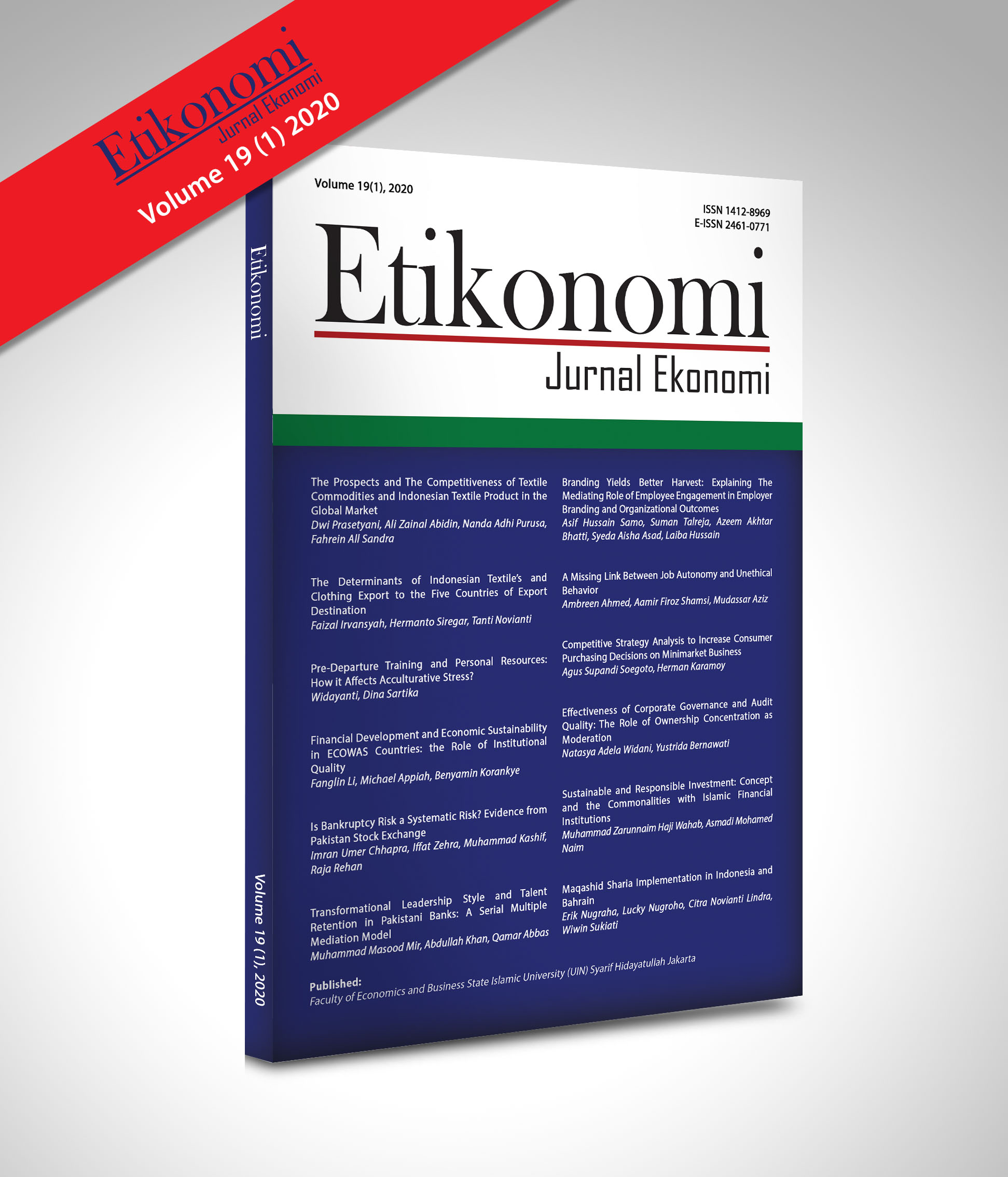Is Bankruptcy Risk a Systematic Risk? Evidence from Pakistan Stock Exchange
DOI:
https://doi.org/10.15408/etk.v19i1.11248Keywords:
distress risk, systematic risk, bankruptcy, asset pricing, Pakistan stock exchangeAbstract
This study empirically investigates the relationship between default risk and cross-section of stock returns in the Pakistan Stock Exchange (PSX). Stock price data from all listed and delisted companies use to calculate monthly returns from 2001-2016. Ohlson's O-score is employed to measure exposure of firm to systematic deviation within bankruptcy risk. Besides, asset-pricing models like the Capital Asset Pricing Model (CAPM) and Fama French (FF) models are employed. Portfolios are sorted in deciles by default probability. This result finds that stocks of firms significantly exposed to not diversified Default Risk yield higher returns. Besides that, the FF models explain cross-sectional stock returns since factors incorporate information on financial distress and default. After that, the book-to-market equity factor is not significant in elucidating returns of distressed firms because of market inefficiency. Results have practical implications for portfolio managers and investors of an emerging economy in developing diversified portfolios during periods of uncertainty and market volatility.
JEL Classifications: G12, G15, G33
How to Cite:
Chhapra, I. U., Zehra, I., Kashif, M., & Rehan, R. (2020). Is Bankruptcy Risk a Systematic Risk? Evidence from Pakistan Stock Exchange. Etikonomi: Jurnal Ekonomi, 19(1), 51 – 62. https://doi.org/10.15408/etk.v19i1.11248.
Downloads
References
Agarwal, V., & Taffler, R. (2008). Does Financial Distress Risk Drive the Momentum Anomaly? Financial Management, 37(3), 461-484. https://doi.org/10.1111/j.1755-053X.2008.00021.x.
Altman, E, I. (1968). Financial Ratios, Discriminant Analysis and the Prediction of Corporate Bankruptcy. The Journal of Finance, 23(4), 589-609.
Anginer, D., & Yildizhan, C. (2018). Is There a Distress Risk Anomaly? Pricing of Systematic Default Risk in the Cross Section of Equity Returns. Review of Finance, 22(2), 633–660
Artikis, P., & Nifora, G. (2011). The Industry Effect on The Relationship Between Leverage and Returns. Eurasian Business Review, 1(2), 125–144. https://doi.org/10.14208/BF03353802.
Boualam, Y., Gomes, J. F., & Ward, C. (2017). Understanding the Behavior of Distressed Stocks. Discussion paper University of North Carolina, University of Pennsylvania, and University of Minnesota.
Campbell, J. Y., Hilscher, J., & Szilagyi, J. (2008). In Search of Distress Risk. The Journal of Finance, 63(6), 2899–2939.
Chan, K. C., & Chen, N. F. (1991). Structural and Return Characteristics of Small and Large Firms. The Journal of Finance, 46(4), 1467-1484
Chava, S., & Purnanandam, A. (2010) Is Default Risk Negatively Related to Stock Returns? The Review of Financial Studies, 23(6), 2523–2559.
Chen, L., Novy-Marx, R., & Zhang, L. (2010). An Alternative Three–factor Model. Working Paper. University of Rochester.
Dichev, I. (1998). Is the Risk of Bankruptcy a Systematic Risk? The Journal of Finance, 53(3), 1131- 1147
Eisdorfer A., Goyal A., & Zhdanov, A. (2015). Distress Anomaly and Shareholder Risk: International Evidence. Working Paper. University of Lausanne.
Fama, E. F., & French, K. R. (1992). The Cross-Section of Expected Stock Returns. The Journal of Finance, 47(2), 427-466.
Fama, E. F., & French, K. R. (1993). Common Risk Factors in The Returns on Stocks and Bonds. The Journal of Financial Economics, 33(1), 3-56.
Fama, E. F., & French, K. R. (1996). Multifactor Explanations of Asset Pricing Anomalies. The Journal of Finance, 51(1), 55-84.
Ferguson, M. F., & Shockley, R. L. (2003). Equilibrium “anomalies.” Journal of Finance, 58(6), 2549-2580.
Gao, P., Parsons, C. A., & Shen, J. (2018). Global Relation between Financial Distress and Equity Returns. The Review of Financial Studies, 31(1), 239–277.
Garlappi, L., Shu, T., & Yan, H. (2006). Default Risk, Shareholder Advantage, and Stock Returns. The Review of Financial Studies, 21(6), 2743–2778.
Garlappi, L., & Yan, H. (2011). Financial Distress and The Cross-Section of Equity Returns. The Journal of Finance, 66(3), 789-822
George, T. J., & Hwang, C. (2010). A Resolution of The Distress Risk and Leverage Puzzles in The Cross Section of Stock Returns. Journal of Financial Economics, 96(1), 56-79. https://doi.org/ 10.1016/j.jfineco.2009.11.003.
Gormley T. A., & Matsa D. A. (2016). Playing it Safe? Managerial Preferences, Risk, and Agency Conflicts. Journal of Financial Economics, 122(3), 431-455. https://doi.org/10.1016/j.jfineco. 2016.08.002.
Griffin, J. M, & Lemmon, M. L. (2002). Book-to-Market Equity, Distress Risk, and Stock Returns. Journal of Finance, 57(5), 2317–2336
Harvey, C. R., & Siddique, A. (2000). Conditional Skewness in Asset Pricing Tests. Journal of Finance, 55(3), 1263–1295. https://doi.org/10.1111/0022-1082.00247.
Idrees, S., & Qayyum, A. (2018). The Impact of Financial Distress Risk on Equity Returns: A Case Study of Non-Financial Firms of Pakistan Stock Exchange. Journal of Economics Bibliography, 5(2), 49-59. https://doi.org/10.1453/jeb.v5i2.1623.
Lai, S., Li, H. C., Conover, J. A., Wu, F., & Li, B. (2018). Stock Returns and Financial Distress Risk: Evidence from the Asian-Pacific Markets. Research in Finance, 33, 123–158. https://doi.org/10.1108/S0196-382120170000033007.
Li, K., Lockwood, J., Miao, H. (2017). Risk-Shifting, Equity Risk, and the Distress Risk Puzzle. Journal of Corporate Finance, 44, 275-288.
Leary, M., & Roberts, M. (2005). Do Firms Rebalance Their Capital Structures? Journal of Finance, 60(6), 2575-2619. https://doi.org/10.1111/j.1540-6261.2005.00811.x.
Kapadia, N. (2011). Tracking Down Distress Risk. Journal of Financial Economics, 102(1), 167–182. https://doi.org/10.1016/j.jfineco.2011.05.004.
Kayhan, A., & Titman, S. (2007). Firms’ Histories and their Capital Structures. Journal of Financial Economics, 83(1), 1-32. https://doi.org/10.1016/j.jfineco.2005.10.007.
Merton, R. C. (1974). On the Pricing of Corporate Debt: The Risk Structure of Interest Rates. The Journal of Finance, 29(2), 449-470. https://doi.org/10.1111/j.1540-6261.1974.tb03058.x.
Mselmi, N., Hamza, T., Lahiani, A., & Shahbaz, M. (2019). Pricing Corporate Financial Distress: Empirical Evidence from the French Stock Market. Journal of International Money and Finance, 96, 13-27. https://doi.org/10.1016/j.jimonfin.2019.04.008.
Ohlson, J. (1980). Financial Ratios and the Probabilistic Prediction of Bankruptcy. Journal of Accounting Research, 18 (1), 109-31.
Schneider, P., Wagner, C., & Zechner, J. (2016). Low Risk Anomalies? CFS Working Paper Studies. Center for Financial Studies.
Vassalou, M., & Xing, Y. (2004). Default Risk in Equity Returns. The Journal of Finance, 59(2), 831-868.










